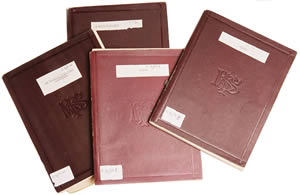|
Clark has long had admirers, nationally and locally,
among democrats and republicans. The recent debate over the Republic
refocused attention on his conception of the legally independent
Commonwealth, and his constitutional thinking has become more rather
than less influential in federal jurisprudence.
There is now broad agreement that his role in
Federation more than justifies Sir William Deane’s description
of him ‘as the primary architect of our constitution’.
Still, he deserves to be better known and appropriately commemorated
in his home-state. The unassuming headstone which once marked his
grave stands at the corner of Nelson Rd and Peel St as his only
tangible memorial.

Some of Clark's
books of essays. View
larger photo
In 1991 a conference on Clark’s contribution
to Australian democracy was organised by Marcus Haward and James
Warden, and the papers were published as An Australian Democrat.
The Life, Work and Consequences of Andrew Inglis Clark by the
Centre for Tasmanian Historical Studies in 1995.
For the Centenary of Federation (2001), the University
of Tasmania has made Clark the focus of its celebrations. A public
lecture and symposium were held in the university on 27-28 September2001,
and two major new books have been published by the Schools of Law
and History and Classics: Frank and Lawrence Neasey, Andrew Inglis
Clark, and Richard Ely (ed.), A Living Force. Andrew Inglis
Clark and the Ideal of the Commonwealth. Proceeds from the sale
of these books will go into university scholarships and prizes.
See also Obituaries:
Two remembrances of Clark.
|